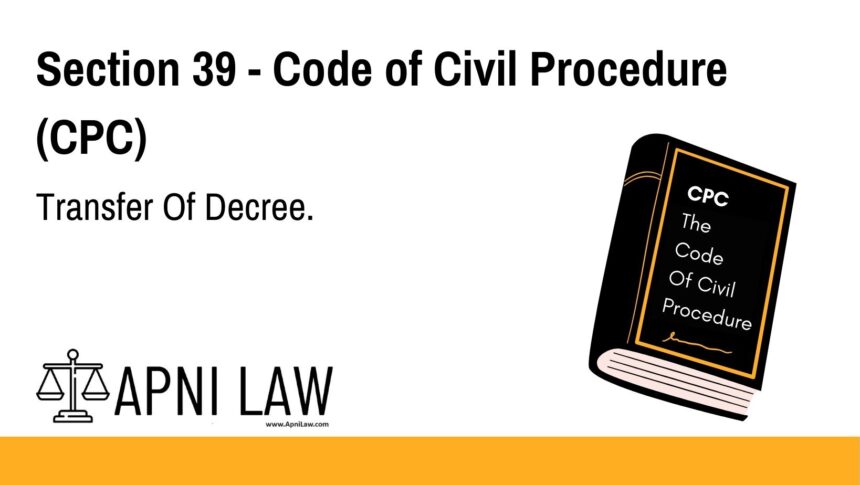Code
CPC(1) The Court which passed a decree may, on the application of the decreeholder, send it for execution to another Court1[of competent jurisdiction],(a) if the person against whom the decree is passed actually and voluntarily resides or carries on
business, or personally works for gain, within the local limits of the jurisdiction of such other Court, or(b) if such person has not property within the local limits of the jurisdiction of the Court which
passed the decree sufficient to satisfy such decree and has property within the local limits of the
jurisdiction of such other Court, or(c) if the decree directs the sale or delivery of immovable property situate outside the local limits of
the jurisdiction of the Court which passed it, or(d) if the Court which passed the decree considers for any other reason, which it shall record in
writing, that the decree should be executed by such other Court.(2) The Court which passed a decree may of its own motion send it for execution to any subordinate
Court of competent jurisdiction.1[(3) For the purposes of this section, a Court shall be deemed to be a Court of competent jurisdiction if, at
the time of making the application for the transfer of decree to it, such Court would have jurisdiction to try the
suit in which such decree was passed.]2[(4) Nothing in this section shall be deemed to authorise the Court which passed a decree to execute
such decree against any person or property outside the local limits of its jurisdiction.]
Perfect 👍 This is Section 39 CPC – Transfer of Decree. I’ll now draft a full SEO-optimized article in ApniLaw format, with proper code quoting, explanation, internal linking, illustrations, FAQs, and conclusion.
Section 39 CPC: Transfer of Decree
Code
Section 39 – Code of Civil Procedure
(1) The Court which passed a decree may, on the application of the decree-holder, send it for execution to another Court of competent jurisdiction, –
(a) if the person against whom the decree is passed actually and voluntarily resides or carries on business, or personally works for gain, within the local limits of the jurisdiction of such other Court; or
(b) if such person has not property within the local limits of the jurisdiction of the Court which passed the decree sufficient to satisfy such decree and has property within the local limits of the jurisdiction of such other Court; or
(c) if the decree directs the sale or delivery of immovable property situate outside the local limits of the jurisdiction of the Court which passed it; or
(d) if the Court which passed the decree considers for any other reason, which it shall record in writing, that the decree should be executed by such other Court.
(2) The Court which passed a decree may of its own motion send it for execution to any subordinate Court of competent jurisdiction.
(3) For the purposes of this section, a Court shall be deemed to be a Court of competent jurisdiction if, at the time of making the application for the transfer of decree to it, such Court would have jurisdiction to try the suit in which such decree was passed.
(4) Nothing in this section shall be deemed to authorise the Court which passed a decree to execute such decree against any person or property outside the local limits of its jurisdiction.
📖 Source: Section 39 CPC – Transfer of Decree (ApniLaw)
Explanation
Section 39 CPC lays down the rules for transferring a decree from the Court which passed it to another Court for execution.
- Normally, under Section 38 CPC, a decree is executed either by the Court which passed it or the Court to which it is sent.
- Section 39 specifies the grounds and procedure for such transfer.
Key Grounds for Transfer:
- Residence or business of judgment debtor (clause a): If the judgment debtor resides, carries on business, or works for gain within another Court’s jurisdiction.
- Location of property (clause b & c): If the judgment debtor has property outside the jurisdiction of the original Court, or immovable property is situated outside.
- Discretionary grounds (clause d): If the Court believes execution is better handled by another Court, it must record reasons.
- Suo motu transfer (sub-section 2): The Court can transfer decrees on its own to a subordinate Court.
- Competent jurisdiction (sub-section 3): The transferee Court must have jurisdiction to try the original suit if it were filed at the time of transfer.
- Limitation (sub-section 4): The original Court cannot directly execute against property or persons outside its jurisdiction—it must transfer.
Thus, Section 39 ensures efficient execution of decrees across territorial jurisdictions.
Illustrations
- Example 1:
A decree is passed in Delhi District Court against a businessman who permanently resides in Mumbai. The decree can be transferred to Mumbai Court for execution under Section 39(1)(a). - Example 2:
A decree-holder wins a money decree in Court A, but the judgment debtor has no property in that jurisdiction. However, he owns a house in Court B’s jurisdiction. The decree may be transferred to Court B under Section 39(1)(b). - Example 3:
A decree for delivery of land situated outside the jurisdiction of the trial Court must be transferred to the Court where the property is located under Section 39(1)(c). - Example 4:
The trial Court believes that execution proceedings would be faster in another Court due to practical reasons. It may transfer the decree under Section 39(1)(d), but must record its reasons.
Common Questions and Answers
1. Can the original Court execute the decree outside its jurisdiction?
No. As per Section 39(4), the Court cannot execute the decree beyond its territorial limits; it must transfer it.
2. What is meant by “Court of competent jurisdiction”?
As per Section 39(3), a Court is competent if, at the time of transfer, it has jurisdiction to try the suit in which the decree was passed.
3. Is transfer of decree automatic?
No, transfer requires either an application by the decree-holder or suo motu order by the Court.
4. Can multiple Courts execute the same decree simultaneously?
Yes, once properly transferred, execution may proceed in multiple Courts, subject to conditions.
5. Why is Section 39 important?
It allows decree-holders to reach judgment debtor’s assets outside the original Court’s jurisdiction, ensuring enforceability across the country.
Conclusion
Section 39 CPC provides the mechanism for transferring a decree for execution to another Court of competent jurisdiction. It ensures that decrees are not limited by territorial boundaries and can be enforced wherever the judgment debtor or his property is located.
Together with Section 37 CPC and Section 38 CPC, this section creates a comprehensive execution framework under CPC.
👉 For more details, visit: Section 39 CPC – Transfer of Decree (ApniLaw).








